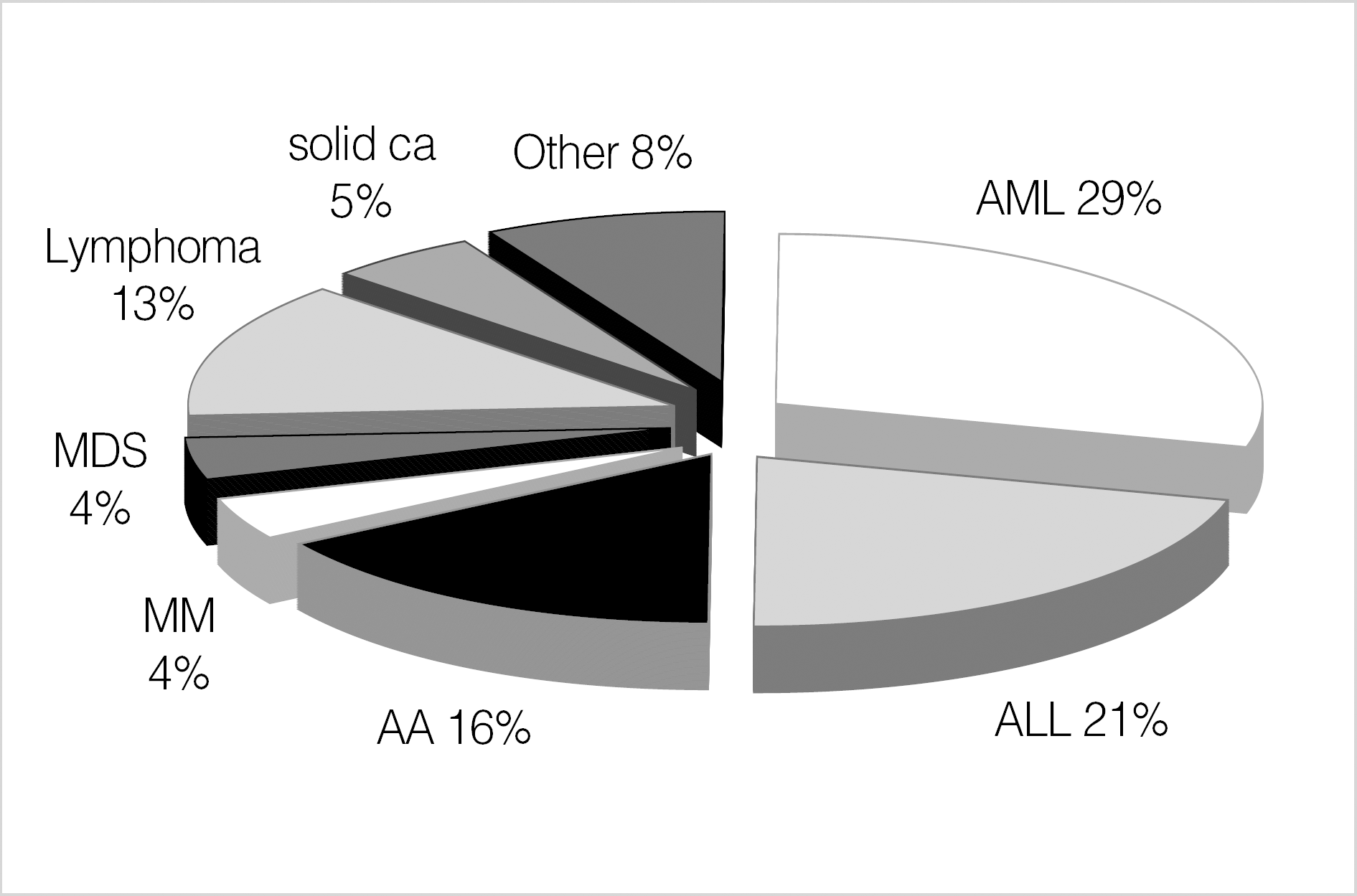Abstract
Background
Irradiated blood is used to prevent transfusion-associated graft-versus host disease in high risk patients. The guidelines for usage of irradiated blood components vary from one country to other according to their needs. But in Korea, little information is available on the current usage of and the guidelines for irradiated blood. Therefore, we analyzed the usage of irradiated blood components in Hanyang University Medical Center.
Methods
Medical records were reviewed for 187 patients who had been transfused with irradiated blood products during the period from January 2004 to June 2005. And we investigated the proportion of irradiated blood products among the total number of blood products that were transfused during a one-year period.
Results
Hematologic diseases and solid cancer patients comprised 63.7% and 24.6% respectively. The proportion of irradiated blood products among the total blood components were 25.7% of platelet concentrates, 61.4% of apheresis platelets, and 5.1% of packed red cells. Total transfused amount by disease categories and the average transfused units per patient of irradiated blood components were high in a group of patients with several hematologic diseases such as acute leukemia.
Conclusions
The use of irradiated blood components takes a great proportion in total blood product transfusions and the majority of blood components were transfused to a group of patients with a few hematologic diseases. The proper use of blood should be guided by the promotion and education of a modified usage protocol for irradiated blood products and by a continuous data analysis.
References
1. Ohto H, Anderson KC. Survey of transfusion-associated graft-versus-host disease in immunocompetent recipients. Transfus Med Rev. 1996; 10:31–43.

2. Seghatchian MJ, Ala F. Transfusion-associated graft-versus-host disease: current concepts and future trends. Transfus Sci. 1995; 16:99–105.

3. Wagner FF, Flegel WA. Transfusion-associated graft-versus-host disease: risk due to homozygous HLA haplotypes. Transfusion. 1995; 35:284–91.

4. Ahya R, Douglas G, Watson HG. Transfusion associated graft versus host disease in an immunocompetent individual following coronary artery bypass grafting. Heart. 1998; 80:299–300.

5. Cassens U, Greve B, Tapernon K, Nave B, Severin E, Sibrowski W, et al. A novel true volumetric method for the determination of residual leucocytes in blood components. Vox Sang. 2002; 82:198–206.

6. Kao KJ, Mickel M, Braine HG, Davis K, Enright H, Gernsheimer T, et al. White cell reduction in platelet concentrates and packed red cells by filtration: a multicenter clinical trial. Transfusion. 1995; 35:13–9.
7. Webb IJ, Anderson KC. Transfusion-associated graft-versus-host disease. Scientific basis of transfusion medicine: Implications for clinical practice. 2nd edition.Anderson KC, Ness PM, ed. Philadelphia: WB Saunders Company;2000. p. 420–6.
9. Kim SI, Han KS, Kwon SW. A New, simple method for preparing leukocyte-poor red blood cells employing intestina1 clamp. Korean J Hematol. 1990; 25:181–5.
10. Hayashi H, Nishiuchi T, Tamura H, Takeda K. Transfusion-associated graft-versus-host disease caused by leukocyte-filtered stored blood. Anesthesiology. 1993; 79:1419–21.

11. Przepiorka D, LeParc GF, Stovall MA, Werch J, Lichtiger B. Use of irradiated blood components: practice parameter. Am J Clin Pathol. 1996; 106:6–11.
12. World Health Organization. International Statistical classification of disease and related health problems,. 10th ed.Geneva: World Health Organization;1992.
13. National Statistical Office. Korean standard classification of diseases. 3rd ed.Seoul: Korean Medical Record Association;1994. p. 1–114.
14. Seo DH, Kang JW, Oh YC, Han KS, Kim SI. Utilization of blood components for transfusion by hospitals in Korea(1998–99). Korean J Blood Transfus. 2001; 12:11–8.
15. Lim YA, Hyun BH. Blood Use According to Diagnoses in Hospitalized Adults of Ajou University Hospital. Korean J Clin Pathol. 2001; 21:79–85.
16. Lee SK, Jeon MJ, Shin JH, Suh SP, Ryang DW. Use of blood components, irradiated and filtered blood products in Chonnam niversity hospital. Korean J Blood Transfus. 1997; 8:231–8.
18. Blood program in Japan. Blood Product Research Organization. 1995.
19. Cha MS, Lee KH, Min YH, Lee KG. Transfusion-associated graft-versus-host disease in patients with acute leukemia. Korean J Dermatol. 1996; 34:345–9.
20. van der Mast BJ, van den Dorpel MA, Drabbels JJ, Claas FH, Weimar W. Transfusion-associated graft vs. host disease after donor-specific leukocyte transfusion before kidney transplantation. Clin Transplant. 2003; 17:477–83.

21. Aoun E, Shamseddine A, Chehal A, Obeid M, Taher A. Transfusion-associated GVHD: 10 years' experience at the American University of Beirut-Medical Center. Transfusion. 2003; 43:1672–6.

22. Yasuura K, Okamoto H, Matsuura A. Transfusion-associated graft-versus-host disease with transfusion practice in cardiac surgery. J Cardiovasc Surg. 2000; 41:377–80.
23. Hume H, Blanchette V, Strauss RG, Levy GJ. A survey of Canadian neonatal blood transfusion practices. Transfus Sci. 1997; 18:71–80.

24. Ohto H, Yasuda H, Noguchi M, Abe R. Risk of transfusion-associated graft-versus-host disease as a result of directed donations from relatives. Transfusion. 1992; 32:691–3.

25. Asai T, Inaba S, Ohto H, Osada K, Suzuki G, Takahashi K, et al. Guidelines for irradiation of blood and blood components to prevent post-transfusion graft-vs.-host disease in Japan. Transfus Med. 2000; 10:315–20.

26. Blood services committee. Guidelines for irradiation of blood and blood components. 2nd ed.New York: New York State council on human blood and transfusion services;2004.
27. Australian and New Zealand society of blood transfusion. Guidelines for gamma irradiation of blood components. 2nd ed.Australia: Australian & New Zealand society of blood transfusion inc.;2003.
Table 1.
Disease categories of the patients transfused with irradiated blood components
Table 2.
Percentage of irradiated blood components to the total blood components for year 2004
| N. of total blood units | N. (%) of irradiated blood units | |
|---|---|---|
| Platelet concentrates | 23,544 | 6,038 (25.7%) |
| Platelet pheresis | 1,174 | 721 (61.4%) |
| Packed red cells | 18,980 | 975 (5.1%) |
Table 3.
Total amount of irradiated blood components used according to disease categories and percentage per total irradiated blood use
Table 4.
Average units of irradiated blood components transfused per person according to disease categories during an 18-month period




 PDF
PDF ePub
ePub Citation
Citation Print
Print



 XML Download
XML Download